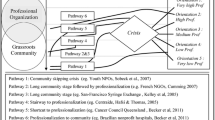Abstract
The study of how nonprofits evolve is fundamental to gaining an appreciation of dynamic nonprofit organizational life, and to developing insight into how nonprofits emerge and transform over time. Using a nonprofit entrepreneurship perspective, this article highlights a number of key methodological challenges associated with the study of nonprofit entrepreneurship, including issues of identification and use of single key informants. The article also provides suggestions how to capture the often “messy” nonprofit entrepreneurship process by pointing to the need for longitudinal data, and by discussing the value of qualitative inquiry and methods.
Similar content being viewed by others
References
Aldrich, H. E., & Yang, T. (2012). What did Stinchcombe really mean? Designing research to test the liability of newness among new ventures. Entrepreneurship Research Journal, 2(3), 1–12.
Andersson, F. O. (2017). A new focus on nonprofit entrepreneurship research: Highlighting the need and relevance of nascent stage inquiry. Nonprofit Management and Leadership, 28(2), 249–258.
Bansal, P., Smith, W. K., & Vaara, E. (2018). New ways of seeing through qualitative research. Academy of Management Journal, 61(4), 1189–1195.
Bess, G. (1998). A first stage organization life cycle study of six emerging nonprofit organizations in Los Angeles. Administration in Social Work, 22(4), 35–52.
Brudney, J. L., & Gazley, B. (2006). Moving ahead or falling behind? Volunteer promotion and data collection. Nonprofit Management and Leadership, 16(3), 259–276.
Cassar, G., & Craig, J. (2009). An investigation of hindsight bias in nascent venture activity. Journal of Business Venturing, 24(2), 149–164.
Cordes, J. J., Steuerle, C. E., & Twombly, E. (2004). Dimensions of nonprofit entrepreneurship: An exploratory essay. In D. Holtz-Eakin & H. S. Rosen (Eds.), Public policy and the economics of entrepreneurship. MIT Press.
Cornforth, C. (2012). Nonprofit governance research: Limitations of the focus on boards and suggestions for new directions. Nonprofit and Voluntary Sector Quarterly, 41(6), 1116–1135.
Davidsson, P. (2006). Nascent entrepreneurship: Empirical studies and developments. Foundations and Trends in Entrepreneurship, 2(1), 1–76.
Davidsson, P. (2003). Method issues in the study of venture start-up processes. Paper prepared for The 17th Nordic Conference on Business Studies, Reykjavik, Iceland, August 13–16.
Dollhopf, E. J., & Scheitle, C. P. (2016). Explaining variations in the nonprofit founding process. Nonprofit Management and Leadership, 27(2), 261–272.
Edenfield, A. C., & Andersson, F. O. (2018). Growing pains: The transformative journey from a nascent to a formal not-for-profit venture. VOLUNTAS: International Journal of Voluntary and Nonprofit Organizations, 29(5), 1033–1043.
Eisenhardt, K. M. (1989). Building theories from case study research. Academy of Management Review, 14(4), 532–550.
Eisenhardt, K. M., & Graebner, M. E. (2007). Theory building from cases: Opportunities and challenges. Academy of Management Journal, 50(1), 25–32.
Gartner, W. B. (2016). Entrepreneurship as organizing: Selected work of William B. Gartner. Edward Elgar Publishing.
Gartner, W. B. (1993). Words lead to deeds: Towards an organizational emergence vocabulary. Journal of Business Venturing, 8(3), 231–239.
Gartner, W.B., Shaver, K.G., Gatewood, E., & Katz, J.A. (1994). Finding the entrepreneur in entrepreneurship. (Editorial). Entrepreneurship Theory & Practice, 18(3), 5–9.
Gawell, M. (2013). Social entrepreneurship: Action grounded in needs, opportunities and/or perceived necessities? VOLUNTAS: International Journal of Voluntary and Nonprofit Organizations, 24(4), 1071–1090.
George, B., & Pandey, S. K. (2017). We know the Yin—But where is the Yang? Toward a balanced approach on common source bias in public administration scholarship. Review of Public Personnel Administration, 37(2), 245–270.
Handy, F., Ranade, B., & Kassam, M. (2007). To profit or not to profit: Women entrepreneurs in India. Nonprofit Management and Leadership, 17(4), 383–401.
Haugh, H. (2007). Community–led social venture creation. Entrepreneurship Theory and Practice, 31(2), 161–182.
Johnson, V. (2007). What is organizational imprinting? Cultural entrepreneurship in the founding of the Paris Opera. American Journal of Sociology, 113(1), 97–127.
Katre, A., & Salipante, P. (2012). Start–up social ventures: Blending fine–grained behaviors from two institutions for entrepreneurial success. Entrepreneurship Theory and Practice, 36(5), 967–994.
Langley, A., Smallman, C., Tsoukas, H., & Van de Ven, A. H. (2013). Process studies of change in organization and management: Unveiling temporality, activity, and flow. Academy of Management Journal, 56(1), 1–13.
Learned, K. E. (1992). What happened before the organization? A model of organization formation. Entrepreneurship Theory and Practice, 17(1), 39–48.
Lecy, J. D., Van Slyke, D., & Yoon, N. (2016). What do we know about nonprofit entrepreneurs?: Results from a large-scale survey. Available at SSRN: https://ssrn.com/abstract=2890231
McMullen, J. S., & Dimov, D. (2013). Time and the entrepreneurial journey: The problems and promise of studying entrepreneurship as a process. Journal of Management Studies, 50(8), 1481–1512.
Ozcan, P., Han, S., & Graebner, M. E. (2017). Single cases: The what, why, and how. In R. Mir & S. Jain (Eds.), The Routledge companion to qualitative research in organization studies (pp. 92–112). Routledge.
Reynolds, P. D. (2000). National panel study of US business start-ups. Background and methodology. In J. A. Katz (Ed.), Advances in entrepreneurship, firm emergence and growth, vol. 4, JAI Press.
Stephenson, M. O., Jr., Schnitzer, M. H., & Arroyave, V. M. (2009). Nonprofit governance, management, and organizational learning: Exploring the implications of one “mega-gift.” The American Review of Public Administration, 39(1), 43–59.
Svensson, K., & Gallo, C. (2018). The creation of an unsolicited organization: Victim Support Sweden. VOLUNTAS: International Journal of Voluntary and Nonprofit Organizations, 29(5), 1008–1018.
Uy, M. A., Foo, M. D., & Aguinis, H. (2010). Using experience sampling methodology to advance entrepreneurship theory and research. Organizational Research Methods, 13(1), 31–54.
Young, D. R. (1983). If not for profit, for what? A behavioral theory of the nonprofit sector based on entrepreneurship. Lexington Books.
Funding
No funding was received for conducting this study.
Author information
Authors and Affiliations
Corresponding author
Ethics declarations
Conflict of interest
The authors have no relevant financial or non-financial interests to disclose.
Additional information
Publisher's Note
Springer Nature remains neutral with regard to jurisdictional claims in published maps and institutional affiliations.
Rights and permissions
About this article
Cite this article
Andersson, F.O. The Exigent Study of Nonprofit Organizational Evolution: Illuminating Methodological Challenges and Pathways Using a Nonprofit Entrepreneurship Lens. Voluntas 33, 1228–1234 (2022). https://doi.org/10.1007/s11266-021-00391-1
Accepted:
Published:
Issue Date:
DOI: https://doi.org/10.1007/s11266-021-00391-1




